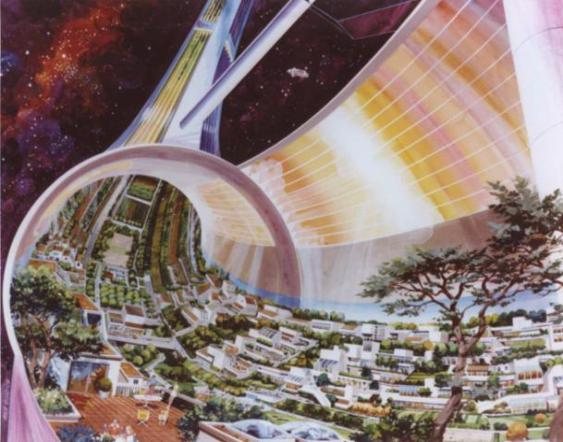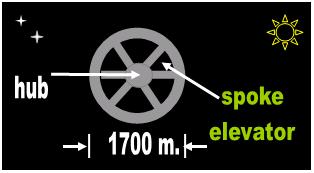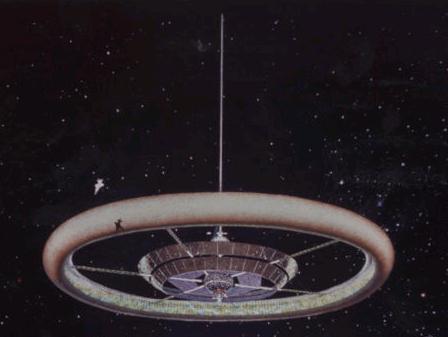| Adapted for the Internet from: Why God Doesn't Exist |
| What if we could travel at c ? |
1.0 What if we traveled at near c
Let’s assume for the sake of argument, and to look at the interstellar problem in light most favorable to the idiots of Mathematics,
that we’ve finally developed the technology to travel at near c. What are the chances of ever making a one-way, 5 year manned
trip to Proxima? (I throw in a small fudge-factor to account for acceleration and deceleration to justify rounding off to the nearest
5.) What other issues should we consider before embarking on such a momentous expedition? Should we just enter the capsule
and take off?
The planned mission to Mars serves as a good example of what project managers take into consideration for manned space
flights. Standard procedure is to explore the targeted celestial object cautiously with a series of unmanned missions first. In
the case of Mars this process has been in progress for some time. What scientists have found out is that sending manned
expeditions to our nearest planetary neighbor along the escape route of the Solar System is not an easy task. The 1969
roundtrip to the Moon, which is about 380,000 kilometers away, took approximately a week including a brief stay-over. If
undertaken today, a round trip to Mars, which is 80 million kilometers away, would take about 2 years. Consensus among
experts is that a minimum of two vehicles would be needed, both of which would have to be assisted gravitationally by Venus.
One way communication to the Soujouner took 11 minutes when Mars was 200 million kilometers away, the limiting factor as
always being the speed of light. On a voyage to Proxima, one-way communication would take 4.3 years or, rounding off, 9 for
a reply. (Voice and e-mail would be magnitudes slower than today’s snail-mail in a Fourth World country!) Robots on the first
missions would have to be designed to operate independently, increasingly more so if they are programmed to disembark
and perform tasks on the surface of a planet. A mission to Mars is likely to be solar-powered, but keep in mind that near the red
planet the power generated by cells reduces to less than half. Cost, safety, and other considerations nevertheless make this a
viable option today. An interstellar voyage would likely have to be nuclear, ion or laser powered, or whatever old-fashioned
Newtonian technology we can concoct next. We cannot rely on liquid or plasma fuel and even less on solar power. Sharp-
shooting skills would have to be honed significantly from where they are today. The Pathfinder fired its thrusters 4 out of a
possible 5 times to correct its trajectory. On a trip to Proxima, any slight miscalculation would veer billions of dollars into
endless space. On a trip to Mars, an astronaut consumes about 1 kg of oxygen, 1.5 kg of dehydrated food, and 2.5 kg of water
per day in space. [M. Collins, Mission to Mars, National Geographic (November 1988) 732-764]. For a crew of 8, this amounts to
about 38 tons of life supporting supplies for two years, not including laundry or wash water. Liquids are recycled; solid wastes
and food are not. On an interstellar voyage, the room necessary for food alone would require a few warehouses, possibly the
size of a small country. Radiation, meteoroids, disease and injuries are potential hazards, but more so isolation, homesickness,
boredom and hostility. Weightless-ness is the most serious problem because of the effects of lack of gravity on the
cardiovascular system and bones. Loss of calcium makes bones brittle, which means that astronauts must exercise 2 to 4 hours
a day or have muscles electronically stimulated throughout the day to prevent physical deterioration. Indeed, some experts
believe that a 2-year mission to Mars cannot be achieved in weightlessness for fear that some of the astronauts may not even be
able to walk upon arrival. Interstellar travel would require a rotating spacecraft to mimic artificial gravity by way of centrifugal
force.
To address this last issue, there was a serious proposal entertained by NASA: a torus that spins in space (Fig. 1). [I. Asimov,
The Next Frontier, National Geographic (July 1976) 76-89]. Think of this spacecraft as something like a wheel with spokes.
The wheel spins and elevators running along the spokes communicate the hub with the torus. The torus is a ring measuring
about 1700 meters in diameter where about 10,000 people live under a constant centrifugal force that imitates gravity. The
torus is divided into 6 areas, three where people live and three where crops are grown and livestock raised for the colony’s
self-provision. This is not totally an off-the-wall idea, but an actual model suggested to NASA by experts in the field, a working
model that some scientists hope will someday become a habitat for humans. The torus is designed for colonization within the
solar system, not for interstellar travel.
- ________________________________________________________________________________________
- Last modified 02/27/08
- Copyright © by Nila Gaede 2008
The rotating wheel is not free of problems, however. It wobbles significantly in space like a spinning top, thus making
communications and steering of the craft more difficult. But assuming scientists correct these technical difficulties and
somehow attach boosters and thrusters to the belly or back of the torus, or push it along with microwaves or lasers, we
could conceivably imagine an entire, self-supporting population hiking to Proxima under conditions similar to those
found on Earth. How would we go about it?
There would have to be powerful reasons for politicians and businessmen to embark on an expensive and risky unmanned
adventure since profits are unlikely within a reasonable period. It goes without saying that the purpose of the mission must
include the eventual sending of humans as one of its goals. Why else would we risk astronomical funds on such an uncertain
voyage?
In order to generate the necessary disposable income in the world budget, the population of the Earth would have to be
significantly greater than it is now. This means that such an experiment is out of the question from a technological, economic,
and political standpoint until at least after mid-century when world population is scheduled to be about 9 billion. Whether we
send a fly-by mission or one which would lock into orbit around a pre-selected planet would be contingent upon the urgency
of the situation on Earth. I will begin by assuming a cheap, light, bare-minimum, fly-by probe to reconnoiter Alpha Centauri.
The purpose of this expedition is scientific and exploratory rather than our last chance at survival and evacuation.
Having taken care of the preliminaries, the ship is pushed out of the Solar System -- hopefully in the ‘right’ direction -- and
with good fortune and a few allowances for trajectory corrections arrives at destination in about 5 years. Once in the
neighborhood, the probe decelerates and begins recording images, which arrive at our TV screens 4.3 years later
(i.e., about 10 years have now gone by). If anything goes wrong, the probe is on its own, and billions of dollars hinge on
how well the robot crew was programmed to handle them.
Was such a risky trip worth the enormous expense?
The answer lies on whether the pictures the probe sends back reveal a potential life sustaining planet or one suitable for
terraforming, but whether such a rudimentary probe will ever have this ability on a fly-by mission is unlikely. For the pictures
to merely show close-ups of a couple of solar-system-like planets orbiting a star is no justification to empty the global
treasury, and this is assuming that the craft happens to pass near an ideal Earth-like planet situated in the ball park of an
Earth-like orbit. It wouldn’t help much for the probe to pass at the outer Pluto-like orbit or for it to dart directly into the heart
of a star. Therefore, if the cost of the initial mission is relatively high, one way or the other, the first expedition may be
designed from the start with the capability to orbit a planet. Otherwise, assuming best case scenario that the first fly-by
probe discovers a suitable planet, we now expeditiously plan a second mission with orbiting capabilities. We must keep in
mind, however, that the chronology of space exploration in our own vicinity has never proceeded at such an astronomical
pace as I am assuming here.
The third experiment would consist of much more sophisticated instrumentation and, for the purposes of discussion, I’ll
save some steps and design it with the ability to land discretionary robots. The ship would presumably have the ability to
discover the targeted planet from afar, change course, lock into orbit, and direct a robot to descend and carry out its tasks.
While the metallic crew sniffs, a lander collects rocks and sees, hears, and analyzes the surrounding area. It is unimaginable
what such an expedition would cost in terms of world GNP. A lot would depend on whether the method of propulsion of the
first probe is reusable. This second probe would undoubtedly take longer to get to Centauri, possibly more than twice as
much because of the much higher payload. Assuming that the planet has a ready-made atmosphere, astronauts could
conceivably be imagined to form part of the next operation. Keep in mind that by now we’ve entered the 22nd Century, and
that we’ve made it look easy by assuming unlikely favorable conditions. The best times we have conceived so far on the
blackboard using trillion dollar lightsails weighing 1 ton is in the neighborhood of 20 years. Whether such probes can be
made to orbit a planet for this amount of money is unlikely, and whether world leaders would be willing to invest so heavily
in such an uncertain enterprise is even more doubtful. I also assumed that the probe passes at the right distance from one
of the three stars and discovers an Earth-like planet or one amenable to terraforming. I proceed with these favorable
assumptions.
The possibility of life as advanced as ours is discounted because we have not received signals from this nearby, tri-star
system, indicating that, if life exists in the Centauri System, it has not mastered electromagnetism. For that matter, we
haven’t received signals from Sun-like stars in a 20 light-year radius either, which means that we will probably have to
revise further downwards our ballpark estimates of intelligent life bearing planets that I initially made. Therefore, my
assumption is that our astronauts would be the first intelligent life to attempt to inhabit a ready-made planet in Proxima
that may have some less developed form of life. The one way trip would ideally take five years (at the speed of light). The
roundtrip, which I haven’t tested up to this point, will take about ten. I leave it to the reader to visualize the excitement
inherent in such fun-filled voyage. We can’t consider cryogenics because we have yet to show that we can bring a human
back to life after a five year glacial age, but I'll proceed as if we solved this problem too. How would weightlessness and
lack of food affect the frozen body? Would the body age? Would the astronauts ever be able to walk again? [1] Would we
risk the automatic thawing system failing so far away?
Barring accidents, irremediable injuries, civil war, or worse, mutation of stowaway cells and viruses that could wipe the
entire crew, the intrepid adventurers could conceivably arrive somewhere in the first quarter of the 22nd Century. With
enough implements to sustain themselves, the astronauts-turned-farmers begin their necessary gardening and
construction chores to pave the way for the first wave of colonists. The last mission of the first stage would consist of a
flotilla of torus-like vehicles carrying settlers, military, ecclesiastical and business representatives, equipment, animals
and plants, all enthusiastically gold-rushing to the New World. I would hope that these arks would at least carry
something more than dehydrated, pre-packaged food to feed the adventurers and their clean andunclean pets.
Sounds reasonable? Are we over-dreaming? Are we possibly extrapolating just a bit too much from history and from TV?
Is space a new kind of ocean? Is the lightsail the covered wagon of the interstellar age?
I can only suggest to all those dreaming trekkies working at space agencies that they seriously revise their Milky Way
plans and come back to Earth. We are going nowhere outside the Solar System! We got more pressing issues here on
Earth!
Fig. 1 Rotating Torus |
2.0 What does it take to terraform another planet?
Now let’s add a higher level of difficulty to take into account the likely scenario our robots would encounter in Proxima. Let
us assume that with some luck the automated crew discovers a planet that has a CO2 atmosphere like Venus or Mars? At
this point we have two options. We can move on to another star a few light-years further on or send a crew of robot
gardeners to convert the land to our liking. How fast can they have Eden ready for Adam?
Of the known celestial objects Mars, Venus, Jupiter’s moons Europa and Io, Saturn’s moons Enceladus and Titan either
have a convertible atmosphere or frozen water or other chemical resources. These are considered to be the best candidates
for terraforming and, of these, Mars is first on the list. The remaining objects floating around in the Solar System are barren
stones just hurtling through space.
Scientists have for many years evaluated the possibility of terraforming Mars, and unfortunately the prospects don’t look too
good. The gargantuan engineering project would proceed in three or four stages.
- 1. The first step would consist in heating the planet with orbiting mirrors to achieve
- an increase in surface temperature of about 50ºC. The higher temperature is
expected to melt the CO2 and water rich polar ice caps, and evaporate vast
quantities of CO2 trapped in silicate rocks. The CO2 would then form a protective
shield around the planet to enable transplanted anaerobic systems to thrive and
prepare the atmosphere for plants. The way it stands now, the pressure on the
planet is too low (about one hundredth that of Earth), the temperature is too cold
(an average of 100 ºC), and there is not a thick enough atmosphere to shield
organisms from UV and cosmic rays. This initial process may take anywhere from
50 to 200 years and would probably not be put into effect until after 2050.
- 2. The second stage consists of transporting and transplanting rugged plants from
- Earth so they can begin the process of photo-synthesizing the CO2 into breathable
air. There is a small catch, however. This part of the process takes 100,000 years.
More crucial yet, this entire process can be put into effect only if the thick CO2 that
once enveloped Mars is concentrated in silicate rock on the planet’s surface. If
these gases evaporated into space in the past, that’s about it for Mars. We either
import CO2 by the teaspoon from the planet’s two moons or rethink our plans
using beautiful Venus as our prototype.
Realistically, the terraforming of planets will never happen. We’re stuck with Earth. Fogg [3] states that terraforming will
nevertheless not happen for another 100 years.
A more formidable obstacle to overcome is politics and economics. We lack the will because we lack the resources to
carry out such an impossible task.

| Hip, hip, hooray! Folks, we're finally on our way to Alpha C. in our state-of-the-art torus! Let's hear it for the politicians on Earth who finally mustered the will and provided the funds to get us out of that hell! I am convinced that if we all pray from our hearts, we will find a suitable planet over there and, who knows? Maybe in a couple of hundred years, we'll be exporting bananas and peanuts to Earth. |

| The torus is designed to house 10,000 people, who live around half the wheel. The other half is allocated to food pro- duction. The torus rotates to generate artificial gravity, so feet and plant roots point radially towards space. Elevators running along the spokes take people to the hub (where there is no gravity). This is the arrival point for travelers (i.e., the airport). |

- Module main page: Why we won't colonize the Solar System or travel to the stars
Pages in this module:
- 1. Mother Nature's Grand Plan
2. Speed is of the essence: Why we will never travel to the nearest star
3. This page: What if we could travel at c?
4. News Flash: The politicians unanimously vote to allocate trillions for a tour to the nearest star

| I think I better begin terraforming Mars for my favorite creation. The Earth is simply getting too crowded |



| Ummmh, Captain Al? We were so worried about weightlessness and losing calcium and getting our gear together that some things fell through the cracks. Uummhh, Lieutenant Newt believes that we left the seeds on Earth. |
| We're almost there folks! That's Proxima Centauri on the right, and we are very lucky. There seems to be one habitable planet. Thank God! So everybody, listen up. Get your shovels and plows ready. We got a lot of work to do and ... what Bill? |

